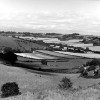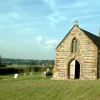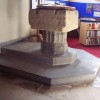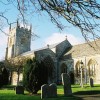Against the wishes of King Edgar’s widow, his eldest son Edward was crowned king after his death. Queen Elfrida had petitioned for her own six-year-old son, Ethelred, to be crowned king but in this she failed. Elfrida inherited Corfe Castle where she lived with her young son and spent her time scheming and plotting the downfall of her step-son.
On March the 18th AD 978 King Edward died – killed by one of his step-mother’s servants, as she offered him a kiss and a goblet of wine.
Edward was fifteen when he became king, but for all his youth he was popular and respected by his subjects. He was eighteen when he came to the Isle of Purbeck to hunt in the royal chase; when he became separated from his party he decided to drop-in on his half-brother at Corfe Castle. While he waited at the castle gate to be admitted a message was sent up to Elfrida who, we must assume, immediately seized the opportunity to rid herself of the obstruction to her son becoming king.
Elfrida came down the steep slope from the Keep to what is now known as Martyr’s Gate to greet Edward and invite him into the castle. Sensing he was in danger Edward declined her invitation saying he only wished to greet his brother and then be on his way. A servant arrived at the gate with a goblet of wine and as Edward raised it to his lips with his right hand the servant grabbed his left arm, twisted it behind him and stabbed him in the back. Some versions of the story suggest that Elfrida herself stabbed Edward but it seems more likely that she distracted him with the offer of a kiss as he was raising the goblet to drink, giving the servant every opportunity to stab the king.
Edward immediately pressed his spurs to his horse, cleared the gate and galloped-off; he had been severely wounded. He fainted from loss of blood, fell from his horse and was dragged by the stirrup down the steep hill to the brook at the bottom, where the horse came to a halt.
Running after him, Elfrida’s servants found his lifeless body badly mutilated as a result of being dragged over the rough stony ground. On Elfrida’s instruction the king’s body was concealed in a well; it wasn’t found until the following year when it was buried at the church of St. Mary in Wareham. Three years later the king’s body was removed to Shaftesbury and with great pomp and ceremony was buried in the Abbey.
The young king was canonised by the Pope as Edward the Martyr. The Church at Corfe Castle, which was founded by St. Aldhelm, was later dedicated to Edward and the days of his murder and the two internments: February 18th and June 20th were ordained to be kept sacred to his memory. According to some accounts Queen Elfrida went to a nunnery in Bere Regis where she became Abbess. Elfrida’s son did become king but King Ethelred the Unready ruled over a period of conflict with the Danes, who repeatedly overran the country. He was the father of two later kings: Edmund Ironside and Edward the Confessor.
The story of the events at Corfe Castle on March 18th AD 978 is confirmed by the examination of King Edward’s bones after they were discovered during excavations at Shaftesbury Abbey. On the left side both leg and arm were broken in two places and the neck, right arm, hip and leg were fractured, these injuries being consistent with the assault on Edward, his escape, fall from the saddle, and being dragged some distance by his horse.



